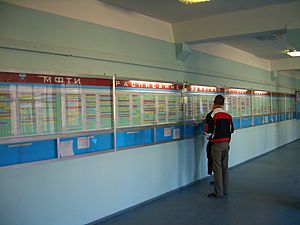Curriculum facts for kids
A curriculum is like a detailed plan for what you will learn in school or during training. Think of it as a roadmap for your education! It explains exactly what subjects will be taught and in what order. It also often suggests how much time should be spent on each topic.
This plan helps teachers know what to teach and helps students understand what they need to learn. Curricula are often approved by official groups, like examination boards. These groups also use the curriculum to create tests and exams.
Today, a curriculum usually means all the courses, their content, and the homework you do at a school or university. Sometimes, new curricula are created to improve how things were taught before. Textbooks and teacher training courses are often based on a specific curriculum. Learning about curricula is an important part of becoming a teacher.
A word similar to curriculum is syllabus. A syllabus is a shorter summary of the topics you will cover in a specific class or course. Another related word is discipline, which in this case means a subject you study, like science or history.
How Curricula Developed Over Time
Historically, curricula have done more than just guide what's taught and tested. They have also looked at the reasons behind teaching. They consider many important things, such as:
- How children learn and develop, especially younger kids.
- What society needs, including the skills employers are looking for.
- New discoveries and knowledge, for example, in science.
- The difference between general education and specific job training.
- Whether education is required by law or is something people choose to do.
A famous educator named Ralph Tyler asked four key questions about curricula. These questions are still seen as very important today:
- What should students learn in school?
- How can we choose learning activities that help students reach these goals?
- How can these learning activities be organized so they are taught effectively?
- How can we check if students are actually learning what they are supposed to?
There are no simple answers to these questions. Different ideas about education have always existed, based on different views of life and learning. Generally, these ideas fall into two main types.
One type is called child-centered education. This approach focuses on adapting teaching to fit the needs and development of each individual child. You often see this approach in kindergarten and elementary schools.
The other type is society-oriented education. This approach aims to make sure society has enough young adults ready to fill the jobs and roles it needs. In some places, the approach might be more focused on religion. This would aim to help young adults live according to the beliefs and practices of a specific religion.
Related School Topics
Images for kids
-
Brown University celebrated 50 years of their Open Curriculum in 2019. This curriculum allows students to choose many of their own courses.
See also
 In Spanish: Currículo (educación) para niños
In Spanish: Currículo (educación) para niños






